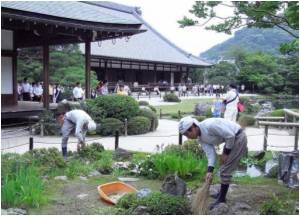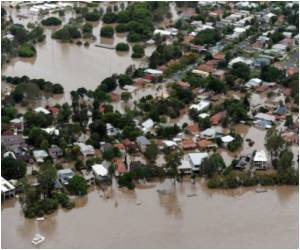Developing countries have to be prepared for natural calamities like earthquakes and tsunamis and take steps to modernize their disaster management systems.

The earthquake was also felt in neighboring South Asian countries, and killed 50 people in India, Tibet and Bangladesh. The 7.8-magnitude quake had an epicenter about 50 miles from Kathmandu and 50 miles east of Pokhara. Rescue operations are going on in Nepal with the help of thousands of aid groups proving shelter, food, water, blankets and medical treatment.
What is an Earthquake?
An earthquake shaking caused by a rapid movement of rock in the earth’s crust. Such movements usually take place along thin zones of crushed rock separating blocks of crust called faults. When one block rapidly slip and moves relative to the other along a fault, the energy released generates seismic waves. These waves radiate up through the crust to the earth surface, creating the ground shake.
Why Do Earthquakes Happen?
Earthquakes are caused by stress that develops over time as blocks of Earth’s crust try to move but are held in place by friction along a fault. Earthquakes may last up to several minutes or only a few seconds. They can occur at any time. When the pressure to move gets more strength than the friction holding them together, adjoining blocks of crust slip suddenly rupturing the fault. This creates an earthquake.
How Do Earthquakes Affect People?
Earthquakes of larger magnitude, which release more energy during fault ruptures, can be hazardous. The stronger ground shaking is unlikely to affect people directly. It is what these ground shakings can do to the natural and man-made environments around us that can affect us by endangering our lives and property.
Bigger earthquakes can generate many sources of potential harm. In the natural environment, such hazards include:
- Landslides or avalanches
- Surface faulting or surface rupture: It is displacement that reaches the earth's surface during slip along a fault.
- Tsunami: It is triggered by earthquake-induced underwater landslides or surface faulting on the floor of the ocean.
- Liquefaction: This is a state in which water-logged soils temporarily lose strength and behave like liquids, causing the ground to sink.
- Flash floods: This can be caused by liquefaction near rivers or lakes. Earthquakes can also create a variety of hazards in the built environment. People can be injured or killed by falling or collapsing infrastructures such as residential and non-residential buildings. It can disrupt transportation such as railways, ports and airports. It can also affect utilities, such as distribution lines for water, electric power, telecommunications and natural gas.
- Kathmandu, Nepal - ranked first
- Tokyo, Nagoya and Kobe in Japan
- Istanbul, Turkey
- Quito, Ecuador
- Manila, Philippines
- Islamabad, Pakistan
- San Salvador, El Salvador
- Mexico City, Mexico
- Izmir, Turkey
- Jakarta, Indonesia
- Guwahati in Assam and Srinagar in Jammu and Kashmir Guwahati and Srinagar are at the highest risk for earthquakes in India. The cities fall in very severe earthquake intensity zone.
- New Delhi The Indian capital city is also highly prone to earthquakes. Delhi falls into the zone four category of the seismic zone divisions in India. Delhi has been seen five devastating earthquakes since 1720.
- Mumbai- Maharashtra
- Chennai- Tamil Nadu
- Pune- Maharashtra
- Kochi- Kerala
- Kolkata- West Bengal
- Thiruvananthapuram- Kerala
- Patna- Bihar
- Ensure your house meets earthquake-construction requirements
- Firmly secure bookcases, artwork and home appliances to withstand as much shaking as possible
- Prepare an earthquake emergency kit. It should have non-perishable food, water, flashlights, first aid materials and other essential items
- Plan an alternative commuting routes in case of road damage
- Teach your family basic first aid
- Instantly seek a safe location such as a doorway or hide beneath a table or desk
- Cover your head with a helmet to minimize injury
- Do not take elevators during an earthquake
- If you are outside, stay in open areas. Stay away from buildings, trees and power lines
- If you are driving, stop the vehicle and stay in it. Do not stop near power lines, bridges and overpasses
How does a Seismograph Work?
A seismograph is an instrument that is used to measure earthquakes. The device accurately records the motion of the ground during a quake. Seismograph contains seismometer, which may be a pendulum or a mass mounted on a spring.
When the earth shakes a seismograph is securely mounted onto the surface of the earth. The entire unit shakes with the earth. But the mass on the spring doesn’t shake and remains in the same place. As the seismograph shakes under the mass, the recording device on the mass records the relative motion between itself and the rest of the instrument thus recording the ground motion.
What is Richter scale?
The Richter scale is a standard logarithmic scale that is used to compare earthquakes. The numbers on the scale measure factors of 10. An earthquake that measures 4.0 on the Richter scale is 10 times larger than a 3.0 earthquake. Anything below 2.0 is undetectable and it is called a micro-quake.
Any earthquake that is above 8.0 will cause major damage to buildings and structures and moderate destruction will take place. A 9.0 and above scale earthquake will cause almost total destruction and will result in permanent changes in ground topography. Such a destructive earthquake occurs once in 10 to 50 years.
Historically, the Chilean earthquake is the largest ever recorded in the 20th Century. It happened on May 22, 1960, in Valdivia, a city in southern Chile with a magnitude of 9.5 Richter, which was equivalent to 178-Gigatons of power.
Though the quake created substantial havoc, most of the casualties came 15 minutes later when a tsunami rose up to 80 feet (25 meters) on the Chilean coastline. The combined effects of the disaster left two million people homeless and killed around 6,000 people; economic losses incurred cost more than $1 billion.
World's Most Vulnerable Cities for Earthquakes
GeoHazards International, a nonprofit research group, measured the most vulnerable cities in Asia and the Americas for seismic calamity.
Earthquake Prone Cities in India
Building Protection against Earthquake
Modern structures need to meet requirements to protect against earthquakes. Many innovative ways are available for such protection. In Japan almost all structures comply to these requirements. These building survive even high Richter scale earthquakes without any significant damage. The foundation of the building is constructed in such a way that the building moves as a unit during the earthquakes. There are both horizontal and vertical requirements in the foundation that needs to be looked at to make the building safe.
Another type of foundation is called floating foundation. Some engineers have also provided solutions by which airbags gets inflated or hydraulic mechanism to lift the building gets activated these are activated by sensors during an earthquake, such levitation though add to the cost of constructions.
Buildings in Japan are constructed with the aid of deep foundation and massive shock absorbers to dampen seismic energy released by an earthquake. Another technique allows the base of a building to move semi-independently to its superstructure.
All two-story school buildings in Japan have evacuation chutes, through which children can slide down to safety. The Japanese government learned valuable lessons from the Kobe earthquake in 1995. The disaster killed around 6,400 people. The government then introduced strict building regulations for residential buildings, offices and transport infrastructure.
Another inovative method of protection has been used in the Taipei 101 storied sky scraper building that stands at 1667-foot (508-meter). It has a 730-ton active mass damper that is housed between the 88th and 92nd floors and this structure sits in a cradle formed by eight steel cables and connects to eight viscous dampers. In Japan too the building regulations ensure that skyscrapers don't collapse even if they sway during earthquakes
How Does Japan Cope with Frequent Earthquakes
Japan is another country where earthquakes occur frequently. So, no country is better prepared than Japan to face earthquakes. Schoolchildren in Japan are given earthquake drills every month. At the sound of an alarm bell that goes off without warning, children retreat under their desks to shelter from falling debris.
The Japanese government also takes children to the earthquake simulation machines every year to familiarize them with the sensation of being in an earthquake. Children are also given counseling to stay in school during earthquakes until an adult comes to collect them, in case their parents aren't available or go missing.
If an earthquake hits Japan, the media instantly switches to official earthquake coverage. The television and radio reports inform the public about prevention methods.
All offices and private houses in Japan keep earthquake emergency kits. The kits include dry rations, drinking water, basic medical supplies, hard-hats and gloves.
Most of the countries, especially developing countries like India, are poorly prepared for disasters including earthquakes and tsunamis. As the global earthquake rate is on the rise, it is time all nations took lessons in disaster management from Japan.
Earthquake Safety Precautions
Knowing what to do when an earthquake strikes and after the event are important factors for survival.










